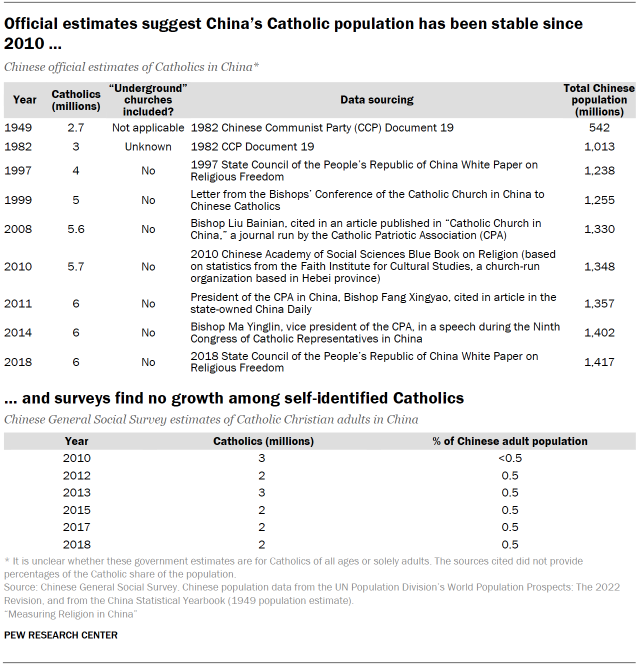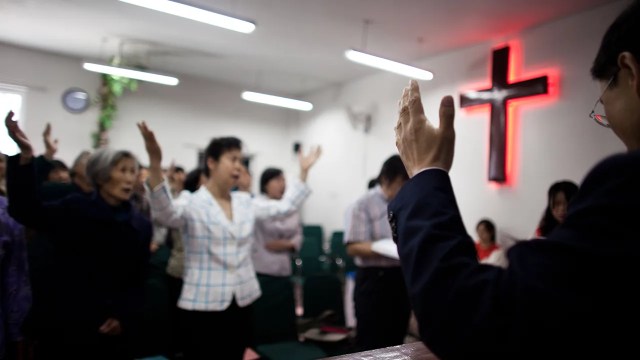
There is a range of estimates for the number of Christians in China, partly because different researchers use varying sources and methods, and partly because some analyses make adjustments to account for limitations in survey and government data.53
One perspective is provided by responses to the Chinese General Social Survey (CGSS) question “What is your religious belief (zongjiao xinyang 宗教信仰)?” In 2018, the CGSS found that roughly 2% of Chinese adults, or about 20 million people, self-identify with Christianity in this way.54 According to this survey, Protestants account for roughly 90% of Chinese Christians, or about 18 million adults, while the remainder are mostly Catholics. Smaller groups, which include Orthodox Christians, are fewer than 1% of Christian adults in China.55
Other national surveys, which use slightly different question wording, report similar shares. In the 2018 World Values Survey, 2% of Chinese adults said they believe in (xinyang 信仰) Christianity, and in the 2016 China Family Panel Studies (CFPS) survey, 3% said they belong to (shuyu 属于) Christianity.
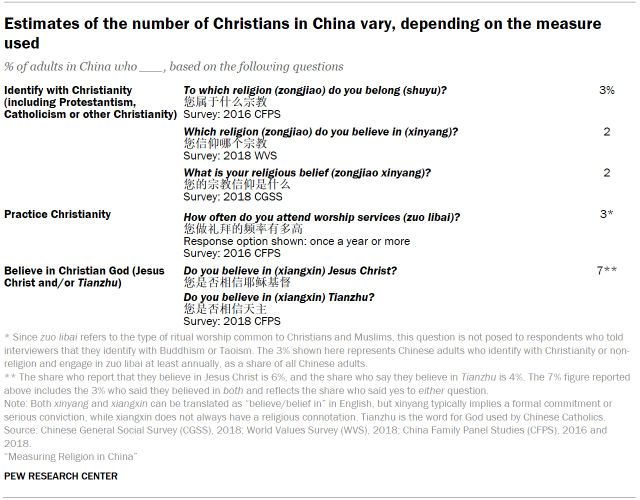
Some media reports and academic papers have suggested the Christian share may be larger, with estimates as high as 7% (100 million) or 9% (130 million) of the total population, including children. No national surveys that measure formal Christian affiliation – by asking people which religion (zongjiao) they identify with – come close to these figures.
However, survey questions that measure Christian beliefs and practices provide evidence that the number of people with some connection to Christian faith is greater than zongjiao measures reveal.
For example, the cumulative share of Chinese adults who say they “believe in” (xiangxin) Jesus Christ and/or Tianzhu (天主, the word Chinese Catholics use for God) is 7%, or roughly 81 million adults, according to the 2018 CFPS survey.
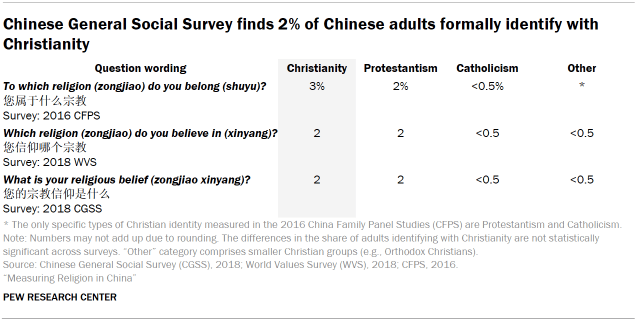
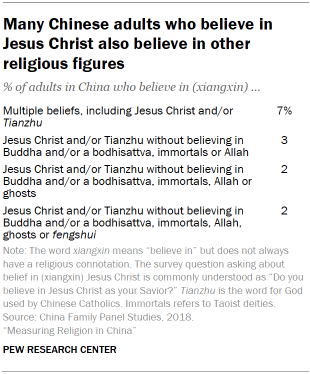
Some scholars argue that this measure may be a better alternative than zongjiao xinyang, citing a core Christian teaching that one should never deny belief in God (including Jesus Christ or Tianzhu) regardless of the circumstances.56
But these figures encompass those who also believe in one or more non-Christian deities, such as Buddha and/or a bodhisattva, immortals (Taoist deities) or Allah. The share of Chinese adults who say they believe in Jesus Christ and/or Tianzhu and do not believe in these other deities is about 3%.
Challenges of measuring Christianity in China
Political sensitivity
Counting Christians in China is difficult for several reasons. Officially, only churches authorized by the government are allowed to operate. But, in reality, many Christians worship in unauthorized venues known as “underground churches” (dixia jiaohui 地下教会) or “house churches” (jiating jiaohui 家庭教会). These Christians may be reluctant to reveal their identity. Likewise, members of the Chinese Communist Party, who are prohibited from holding a religious affiliation, might not disclose their Christian affiliation.57
In recent years, the government has tightened control over Christian activities outside of registered venues, banned unauthorized evangelization online, and intensified its crackdown on unauthorized Protestant meeting points and underground Catholic churches, making Christianity a very sensitive topic in China. In addition, President Xi Jinping has called for the “Sinicization of religions,” a strategy that particularly affects non-traditional belief systems, including Christianity and Islam.
(For more, read the Methodology section “Exploring the underreporting of zongjiao affiliation in Chinese surveys” and discussion of Xi Jinping’s Sinicization campaign.)
Self-identification versus belief and practice
Measuring Christianity in China is also difficult because, as discussed in other chapters, conventional measures of self-identification based on zongjiao do not fully capture the breadth of religious experience in China. And even though Christianity and Islam, unlike Buddhism or folk religions, emphasize exclusivity in belief and practice, many Chinese who engage in Christian practice or even consider themselves to be worshippers of Jesus Christ or Tianzhu may not necessarily identify with Christianity when asked about their zongjiao xinyang.
Looking cumulatively at the broadest, most inclusive survey measures of Christian affinity, as many as 8% of Chinese adults have some degree of connection to Christianity because they formally identify as Christian, believe in the Christian God or report a type of worship attendance common to Christians.
In other words, a broad approach to measuring Christian affinity generates a considerably larger estimate of the number of people with some connection to Christianity than the much smaller share who say Christianity is their zongjiao.
Sampling issues
Sampling coverage, which is tied to the geographic concentration of China’s Christians, may affect the accuracy of Christian estimates. Roughly a quarter of China’s Catholics live in the northern province of Hebei, and they tend to cluster in rural “Catholic villages,” where the vast majority of residents follow Catholicism.58 As a result, Catholic survey estimates may vary depending on how many such villages are included in the sample. Similarly, it is consequential whether Protestants are proportionately represented. For example, surveys may yield a slightly lower Protestant estimate if Wenzhou – said to be the most Christian city in China – is excluded from the sample.
Some researchers argue that surveys that undersample ethnic minority groups may undercount Christians. However, the minority groups in question are relatively small in proportion to China’s population, and Bible distribution figures suggest they make up a small fraction of all Chinese Christians.59
Recent change in Christian measures
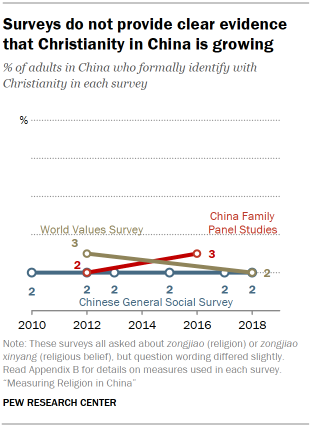
Some scholars and journalists have argued in recent decades that Christianity in China is growing rapidly. Indeed, Christianity flourished after China entered an era of economic reforms and “opening up” to the world in the 1980s. But recent surveys that measure zongjiao affiliation do not offer much evidence that Christian growth continued after 2010.
According to the CGSS, about 2% of adults (23.2 million) in China self-identified as Christian in 2010, versus 2% (19.9 million) in the 2018 survey – a gap that is not statistically significant.60 (In the 2021 CGSS, 1% of respondents identified as Christian. However, this wave did not cover as many regions as previous waves of the CGSS, so the results may not be directly comparable.61)
Since measures of Christian belief and practice have not been repeated consistently in surveys, we cannot track how beliefs and practices associated with Christianity have changed since 2010 in the Chinese public. We don’t know, for example, whether overall belief in Jesus Christ or attendance at Christian worship services (zuo libai 做礼拜) has risen, declined or remained stable.
One of the few repeated survey measures of religious commitment is the broad measure of zongjiao activity, which has been included in all recent CGSS waves. Among those who identify as Christian, reports of zongjiao activity levels are roughly stable. In 2010, 38% of Christians said they engaged in zongjiao activities at least once a week, while in 2018, 35% said so – a difference that is not statistically significant.
Unfortunately, we cannot be certain how survey patterns are affected by political circumstances. There could be a real increase in the share of Chinese adults who identify with Christianity that is hidden from survey measurement. For example, it is possible there has been growth in Christian affiliation that is offset in surveys by growing reluctance among respondents to identify as Christian due to the government’s intensifying scrutiny of Christian religious activity. While that is a hypothetical possibility, there is no way to know from the available survey data whether it is actually the case.
It is also possible that the share of Christians who do not reveal their identity in surveys may have remained roughly stable since 2010. In that case, the apparent leveling off (“plateau”) in Christian identification in recent surveys could be an accurate reflection of the overall pattern, even if surveys fail to capture the full number of Chinese Christians.
Traits associated with formal Christian affiliation
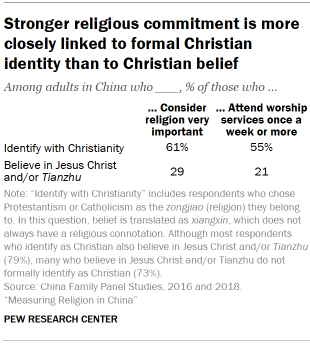
While survey questions that ask about formal zongjiao affiliation have limitations, they capture a subset of Christians who are more religious by several measures than those who say they believe in Jesus Christ and/or Tianzhu.
According to data from the 2016 and 2018 CFPS surveys, 68% of adults who self-identify as Christians believe in Jesus Christ and/or Tianzhu exclusively (i.e., without believing in other deities, including Buddha and/or a bodhisattva, immortals or Allah).62
By contrast, among all those who say they believe in Jesus Christ and/or Tianzhu, only 40% indicate they hold this belief exclusively.
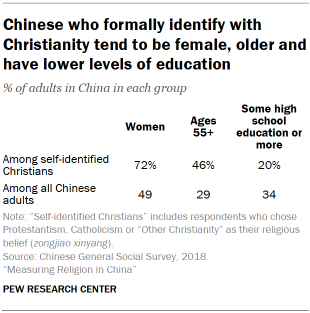
Adults who formally identify with Christianity also are more likely to say religion (zongjiao) is very important in their lives than are those who say they believe in Jesus Christ and/or Tianzhu but do not necessarily formally identify with Christianity (61% vs. 29%), according to the CFPS. And they are more likely to say they attend worship services once a week or more (55% vs. 21%).
According to the 2018 CGSS, respondents who choose Christianity as their zongjiao xinyang are older and have lower educational attainment than the average Chinese adult. The majority (72%) are women.
Christian houses of worship
There are two types of officially sanctioned Protestant places of worship in China: churches (jiaotang 教堂) and meeting points (juhuidian 聚会点). A meeting point is not different from a church functionally, but it may not look like a church building; it can be an apartment or office space and usually holds fewer congregants.
For instance, Haidian Church in Beijing hosts an average of roughly 7,000 people for worship services, while its affiliated meeting points each hold between 150 and 500 people.
In 2009, Protestant venues totaled 55,000 (including roughly 24,000 registered churches and 31,000 meeting points), according to the China Christian Council (CCC) and the Three-Self Patriotic Movement (TSPM). Since then, China’s Protestant supervisory agencies have not broken out churches and meeting points separately.63 According to China’s State Council Information Office, there were roughly 60,000 legal Protestant venues in 2018, largely unchanged from a total of 58,000 venues in 2009.64 These do not include Protestant house churches or unauthorized meeting points.
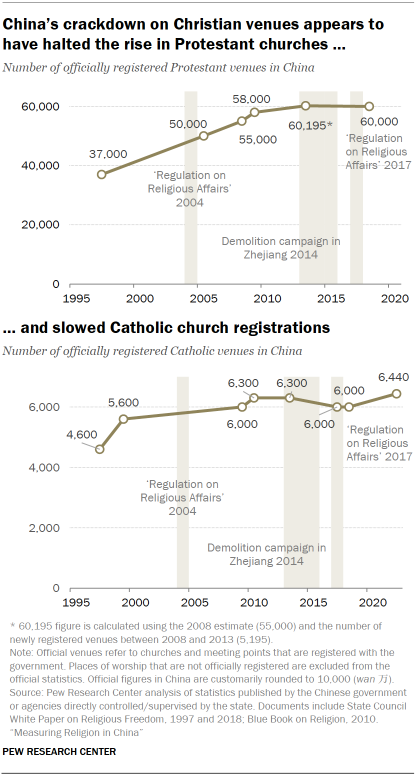
Not all registered meeting points are included in the official statistics of formally registered Protestant venues, a discrepancy that might be explained, at least in part, by the ambiguous meaning of the Chinese words for “register” (dengji 登记 or zhuce 注册). These words can mean either “granted formal registration” or “put on local government record.” The latter may not appear in official statistics.
For instance, Haidian Church in Beijing has more than 50 authorized meeting points, but the CCC and TSPM consider none of the affiliated meeting points a registered venue, even though some of them function much like independent churches, hosting their own worship services and baptisms.
The number of registered Protestant venues, which increased substantially between 1997 and 2008, has roughly leveled off since then.
After 2013, some Protestant churches in Zhejiang – the province with China’s highest concentration of officially registered Christian venues – were affected by the “Three Rectifications and One Demolition” campaign which led to the demolition of some officially sanctioned churches that violated zoning regulations. News reports indicate that officially registered churches later also were demolished in other provinces, including Anhui, Fujian, Henan and Shanxi.
Since 2017, following an update of the “Regulation on Religious Affairs,” authorities have been more strictly implementing policies on unauthorized religious activity. Their strategy has included putting more pressure on venues to affiliate with the TSPM and submit to government oversight, while cracking down on those that resist.
The government’s plan for unauthorized Protestant meeting points has not necessarily led to an increase in official venues, due in part to the ambiguous meaning of “register.” For example, in Tianjin, less than 10% of the total 643 authorized TSPM Protestant meetings have been granted a certificate of registration as of 2019. Similarly, Hohhot, the capital city of Inner Mongolia, has 480 authorized Protestant meeting points, but only 67 of them have been formally registered.
In addition, some scholars believe that local officials in China tend to underreport evidence of religious activity in order to appear compliant with the state’s goal to contain religion. For example, in the Fengxian district of Shanghai, local officials continued to refer to just 24 registered Christian worship sites in 2019, even though in 2018, they reported having accepted 73 (out of 86) unauthorized Christian sites into the official system.
For similar reasons, the trend in the number of registered Protestant clergy seems to conflict with recent government policy pushing for registration. Between 2009 and 2018, the number of official Protestant clergy (pastors, ministers and ordained elders) declined slightly from around 37,000 to 36,000. This trend also appears to conflict with the CCC and TSPM’s emphasis on training Protestant clergy for the official system; around 6,300 students graduated from theological seminaries between 2013 and 2018.
Catholic churches and relations with the Vatican
Government statistics on the numbers of officially registered Catholic venues and personnel – which include only those affiliated with the Catholic Patriotic Association (CPA) – point in slightly different directions.
On the one hand, the number of official Catholic personnel (bishops, priests and nuns) declined from 8,800 in 2009 to 8,000 in 2018. On the other hand, according to official statistics, the number of Catholic venues has grown slightly. In 2022, there were 6,440 officially registered venues (including 4,202 churches and 2,238 sites of worship), up from 6,000 in 2009. (Estimates of churches and worship sites for other years are unavailable.)
Like Protestantism, there are two branches of the Catholic Church in China: the official church and underground churches (dixia jiaohui 地下教会). The former refers to churches that have joined the CPA, which is controlled by the National Religious Affairs Administration, formerly known as the State Administration for Religious Affairs.
The Chinese government has always been wary of underground Catholic churches. Local authorities usually closely monitor covert Catholic activities and pressure priests and bishops to join the CPA as part of an ongoing program to “educate and convert underground Catholic forces.”
This division dates back to the 1950s purge of foreign influence, when the government expelled missionaries and urged Catholic churches to cut ties with the Vatican. Many Catholic laity and clergy who remained loyal to the Vatican carried their faith in secret. During that period, the government recruited several Vatican-ordained bishops to form the CPA and appoint bishops based on the principle of “self-election and self-ordination” (zixuanzisheng 自选自圣) independently of the Vatican.
Christianity was introduced to China during the Tang dynasty in the seventh century, probably by Syriac missionaries of Nestorian Christianity who traveled the Silk Road. The religion did not gain a wide foothold until Jesuit missionaries arrived in the 16th century.65
The Italian Jesuit Matteo Ricci is the most widely known foreign evangelist in China from that time. His strategy of cultural accommodation, such as tolerating the veneration of Confucius and ancestors, helped facilitate conversion among Chinese people. Catholicism continued to expand gradually in China during the 16th century.
China’s relationship with Catholicism subsequently deteriorated. In 1721, the Qing emperor Kangxi, driven by conflicts with papal leadership over the acceptance of traditional Chinese rituals among Catholic converts, forbade the preaching of Catholicism. His successor Yongzheng enforced the ban, and in 1724 condemned Catholicism as heterodox. The emperor also ordered the deportation of most Catholic missionaries.
Protestant Christianity was largely absent from China until the 19th century, but it grew quickly after treaties between Western powers and Chinese governments following the First and Second Opium Wars forced the lifting of restrictions on foreign access – including missionary activity – in certain Chinese coastal areas. This colonial expansion coincided with an evangelical revival in Britain and the United States, leading to a surge in missionary activity in many countries around the world. In China, Protestantism expanded rapidly in the 19th and early 20th centuries in urban areas, as Anglicans, Methodists and other Protestants established schools and hospitals.
The tide for Christianity turned briefly in the early 1920s, when a growing anti-imperialist movement pushed back against Christian expansion. Christianity was labeled an agent of imperialism, and many missionaries were forced to leave.66 During the decade under Chiang Kai-shek’s Nationalist rule (1928-1937), Chinese Christians and foreign missionaries experienced a friendly political environment. Several home-grown Christian movements, such as the True Jesus Church and the Little Flock, were allowed to expand. These Christian denominations continued to attract converts during the period of intense turmoil caused by Japan’s invasion of China (1937-1945) and the Chinese Civil War (1946-1949). By 1949, among the total of 540 million people in China, there were about 700,000 Protestants and 2.7 million Catholics, according to Chinese government estimates.
In the 1950s, following the Communist revolution and the establishment of an officially atheist state, oversight of religious activities became much tighter and more organized. The Chinese government launched the Three-Self Patriotic Movement to reduce outside influence on Christians. Focused on promoting “self-government, self-support and self-propagation” of churches, the program urged Chinese Christian individuals and organizations to cut ties with foreign entities, including the Vatican.67 As part of this movement, the government established “patriotic organizations” to manage and monitor each religious group, including separate agencies to oversee Catholic and Protestant affairs.68 By the late 1950s, virtually all foreign Christian missionaries had been expelled.
During the Cultural Revolution of 1966 to 1976, religious activity was banned. Communist Red Guards persecuted many Christians, especially clergy, and destroyed church buildings. Christianity revived in the 1980s after China lifted the ban on religious activities and opened up to the world. There is little exact data on religious affiliation during that time, but official statistics suggest that the number of Protestants who worship in registered churches more than tripled between 1982 and 1997, from 3 million to 10 million, while China’s total population increased by about 22%.
Underground churches are made up of clergy and laity who reject China’s authority to select bishops and insist on loyalty to the Vatican, while CPA churches pledge loyalty to the Chinese government and espouse the principle of zixuanzisheng.69 As of 2018, there were seven CPA bishops whom the Vatican had not approved, and an estimated 30 to 40 underground bishops whom the Chinese government did not recognize.70
In 2018, China’s relationship with the Vatican was recalibrated when the Vatican signed an agreement allowing the Chinese government to appoint bishops while giving the pope veto power. Since then, Pope Francis has recognized seven previously excommunicated “self-elected and self-ordained” Chinese bishops, while China has appointed eight underground bishops as CPA clergy, bringing the total number of bishops to 66 as of 2022.
Since signing the deal with the Vatican, the government has stepped up efforts to bring Catholic churches into the CPA and intensified its pressure on those that refuse to join.
Geographic distribution of churches
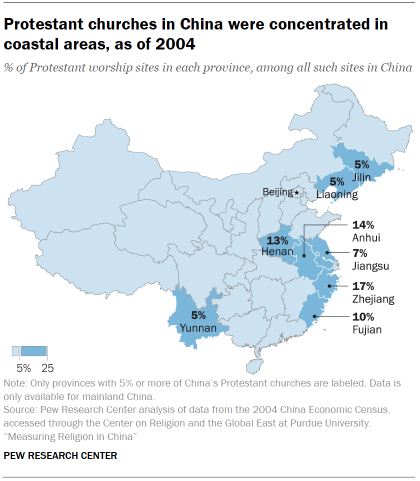
The most recent data on the distribution of Christian worship venues in China is from the 2004 National Economic Census, which shows that Protestant and Catholic churches were concentrated in coastal areas, reflecting the arrival of Christian missionaries by sea.71
(Even though the number of officially registered Protestant and Catholic churches has almost quadrupled since the 2004 enumeration, the data still offers a valuable snapshot of geographic patterns.72)
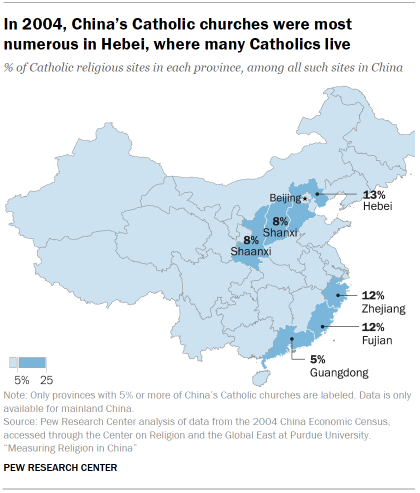
In 2004, Protestant churches were most numerous in the eastern coastal province of Zhejiang (with a 17% share of all Protestant churches in China), followed by the central province of Henan (13%). Zhejiang is home to Wenzhou city, often called “China’s Jerusalem,” while Henan is known as “the Galilee of China.” These distribution patterns may have changed because in 2013 several provincial governments started increasing demolitions of “illegally constructed” churches to curb Christianity’s public presence. Zhejiang was particularly affected.
Catholic churches were most numerous in the northern province of Hebei (13%), home to about a quarter of China’s Catholics, followed by the coastal regions of Fujian (12%) and Zhejiang (12%).
Sidebar: How the number of Protestants, Catholics in China has changed
Over the past decade, some Western scholars and journalists have claimed that Protestant Christianity is booming in China. Some data from the Chinese government and Christian organizations seem to support these claims. However, a closer examination raises questions.
Government estimates
The Chinese government, which has been publishing statistics on Christians sporadically since 1949, estimates that the number of Protestants may have grown from 700,000 in 1949 to 38 million in 2018. However, the 1949 and 2018 numbers do not seem to be directly comparable, because the Chinese government has changed its sourcing and methodology without making appropriate adjustments, and it does not always state whether children are included.73
It also is unclear to what extent the jump from 2008 (20 million) to 2016 (28 million) is driven by new converts or by recategorizing Christians who previously worshipped in unregistered churches. Since 2008, the CCC and TSPM have been carrying out a program of “connecting unauthorized meeting points with an official church” (yitangdaidian 以堂带点) as a new way of regulating unauthorized churches. Under this program, unauthorized meeting points whose leaders agree to affiliate with an official church gain legal status, as they are now considered a branch of a registered church. In other words, an official church could see its membership grow not only through conversion but also by taking in previously unauthorized meeting points.74
Below is a table summarizing all the official estimates of China’s Protestant population that Pew Research Center has found, along with corresponding notes about their origin and what they include.
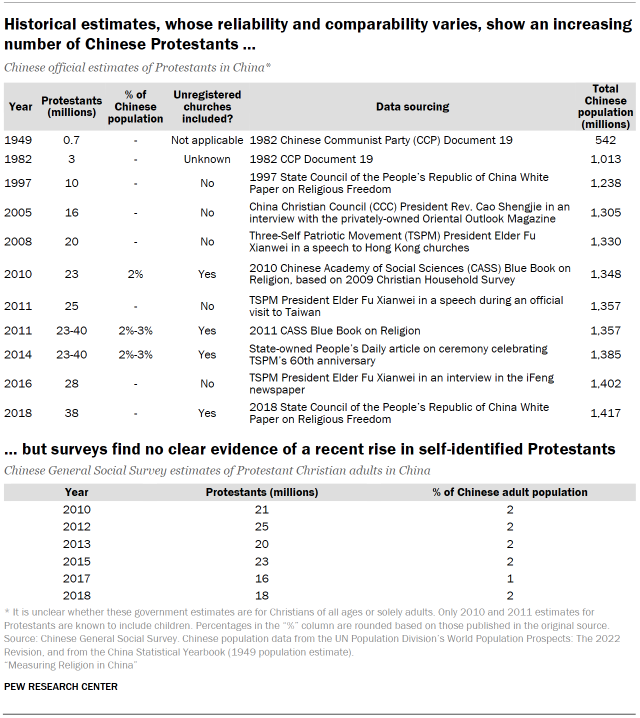
Claims by advocacy groups
International nonprofit organizations and advocacy groups also have published data claiming that Protestants in China have increased sharply. For example, the U.S.-based interdenominational Christian ministry Asia Harvest estimates there were 109.7 million Protestant Christians of all ages in China in 2020 (8% of the country’s total population), up from an estimated 86.9 million (6% of the population) in 2010.75 Asia Harvest’s assessment is based on a secondary analysis of published sources (including government estimates) and interviews with leaders of unregistered churches who granted its research team access to their membership statistics. Asia Harvest may have overcounted Protestants in the official system. Its 2020 estimate of 39.8 million TSPM Protestants is larger than both the 2016 government estimate of Protestants in registered churches (28 million) and the 2018 government estimate of Protestants in registered and unregistered churches (38 million).
Meanwhile, qualitative research points in various directions. On the one hand, CCC and TSPM leaders and senior clergy tend to agree that many rural churches are losing members and revenue because young people are leaving for city jobs.76 (In 2022, China had 296 million such migrant workers, according to China’s National Bureau of Statistics.) On the other hand, many urban churches seem to be thriving, with official churches reportedly becoming crowded and house churches expanding their worship sites to accommodate an inflow of rural Christians.77 In particular, some scholars consider the rise of “newly emerging urban churches” – whose members are often young and highly educated professionals and sometimes returnees from study abroad – an important indicator of Chinese people’s increased interest in Protestantism.78
That said, church membership is not a reliable indicator. For one thing, membership rosters may double-count migrants who have been enumerated both by their rural “home” church and their “receiving” church in the city. Church rosters may also fail to account for members leaving Christianity. An analysis of Christian identification over time using China Family Panel Studies (CFPS) data suggests significant flows both into and out of Christianity.
Among adults who identified with Christianity (3%) in the 2016 CFPS, about a third had not claimed Christianity as their religion when they were previously interviewed in 2012, suggesting that roughly 1% of Chinese adults converted to Christianity between the two survey years.
Meanwhile, among adults who identified with Christianity (2%) in the 2012 CFPS, about a quarter no longer did when asked again about their religion in the 2016 survey. And roughly one-in-five of the adults who self-identified as Christian in 2012 claimed no belief in either Jesus Christ or Tianzhu when reinterviewed in 2018. In other words, while many Chinese people convert to Christianity, some Chinese Christians apparently also leave the faith.
Are Catholics declining as a share of China’s population?
While there are conflicting signals about the trajectory of China’s Protestant population, all available sources suggest that China’s Catholic population is not growing. It is unclear whether the trends are influenced by a possible reluctance among Catholics to identify themselves or engage in church activities, given the impasse between China’s government and the Vatican in the years before a seminal rapprochement in 2018.
According to government figures, the number of people associated with the state-approved Catholic Church held steady at roughly 6 million (less than 0.5% of China’s population), between 2010 and 2018.
Baptism statistics from the church-run Faith Press (Xinde She 信德社) indicate that the numbers of people entering Catholicism may be declining. From the early 2000s to 2010, state-approved churches baptized approximately 100,000 people each year (mostly adults, as children under 18 are not allowed to convert to any religion). By 2017 and 2018, the annual number of Catholic baptisms had fallen by half, to about 48,000.
Data on mainland China that includes “underground” Catholics, gathered by the Holy Spirit Study Centre (HSSC) in Hong Kong, also indicates a decline. According to their analysis, the number of Catholics in China peaked at 12 million in 2005 and slipped to 10 million by 2020. Consistently, the estimated number of ordinations, religious vocations, seminarians and sisters in both official and underground Catholic churches also fell during this period.
In addition, Asia Harvest’s study, which typically produces higher Christian estimates than other sources do, suggests little growth of Catholicism in China. According to Asia Harvest, the number of Catholics remained steady at about 20 million between 2010 and 2020. This includes about 8.3 million people affiliated with the official Catholic Patriotic Association and 11.7 million Catholics outside officially recognized churches.
